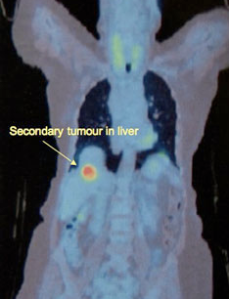I’m back with the promised follow-up to the firefly post. But before I get to fireflies and luciferase, I have to start with cancer cells and metabolism. So how are fireflies and cancer cells related? I promise it will all come together in the end.
Normal cells in our bodies respond to signals around them to decide whether to grow or not. The signals that the cells respond to are called growth factors. Cells will take up food and nutrients from their environment only when instructed to do so by the growth factors. In this way, excess growth and cell division is avoided.
Cancer cells, however, are able to ignore these signals and grow uncontrolled due to mutations in their genes. These mutations can lead to abnormal uptake of food that then leads to cancer cell growth.
In 1924, Otto Warburg observed that cancer cells take up glucose, a main food source, differently than normal cells. In addition to taking up an abundance of glucose, cancer cells turned the glucose into lactate. While normal cells can do this, they do so when oxygen levels are low. Warburg found that cancer cells, however, convert glucose to lactate even when there is plenty of oxygen – a process called aerobic glycolysis. This altered metabolism seen in cancer cells became known as “the Warburg effect.”
 Tumor cells produce lactate even when oxygen is present
Tumor cells produce lactate even when oxygen is present
While the underlying cause of the Warburg effect is still being studied, the altered metabolism has been utilized for tumor imaging. Glucose labeled with a marker can be visualized with a PET (positron emission tomography) scan, a common imaging procedure. Because cancer cells take up more glucose than normal cells, the labeled glucose will be most abundant in cancer cells, highlighting these cells in the resulting PET image. In this way, doctors can pinpoint areas of tumor cells.
In a recent paper from Radiotherapy and Oncology, researchers from Switzerland looked further into the altered metabolism of cancer cells. They aimed to observe changes in cancer cell metabolism upon treatment of the tumor with common therapies.
So, what does this have to do with fireflies? We’re getting there.
Using tumors harvested from mice, the researchers made very thin slices of the tumor tissue. They then measured levels of metabolites, glucose and lactate, in the slices using specific assays – bioluminescent assays. Through an enzymatic reaction, the metabolites in the tumor slices were turned into light so that the amount of light produced indicated the amount of metabolite present in the tumor tissue.
The enzyme that catalyzed these light-producing reactions? Luciferase, of course!
After measuring the amount of light produced from each tumor slice using a high-tech camera, the scientists could compare the levels of metabolites in different tumors. They found that tumors that were treated with cancer therapeutics (called patupilone and IR) had lower levels of lactate and higher levels of glucose as compared to untreated tumors. Decreased lactate levels suggested that less glucose was being converted to lactate. Likewise, increased glucose in the tumor slice suggested that less glucose was being consumed by the cells (and, in turn, made into lactate). In short, the altered metabolite levels in the treated tumors suggested that those cancer cells were reverting back to a more normal metabolism.
 Modified from original manuscript
Modified from original manuscript
The measurement of altered metabolite levels in tumor slices upon treatment could be extremely useful in the therapeutics field. By monitoring changes in cell metabolism in tumors, doctors could predict early in treatment if a therapy was going to be beneficial for a patient. Active monitoring of cancer cell responses to a given therapy could greatly improve cancer patients’ treatment courses.
I think the firefly would be proud to know that its enzyme is working to improve the health of cancer patients, don’t you?


